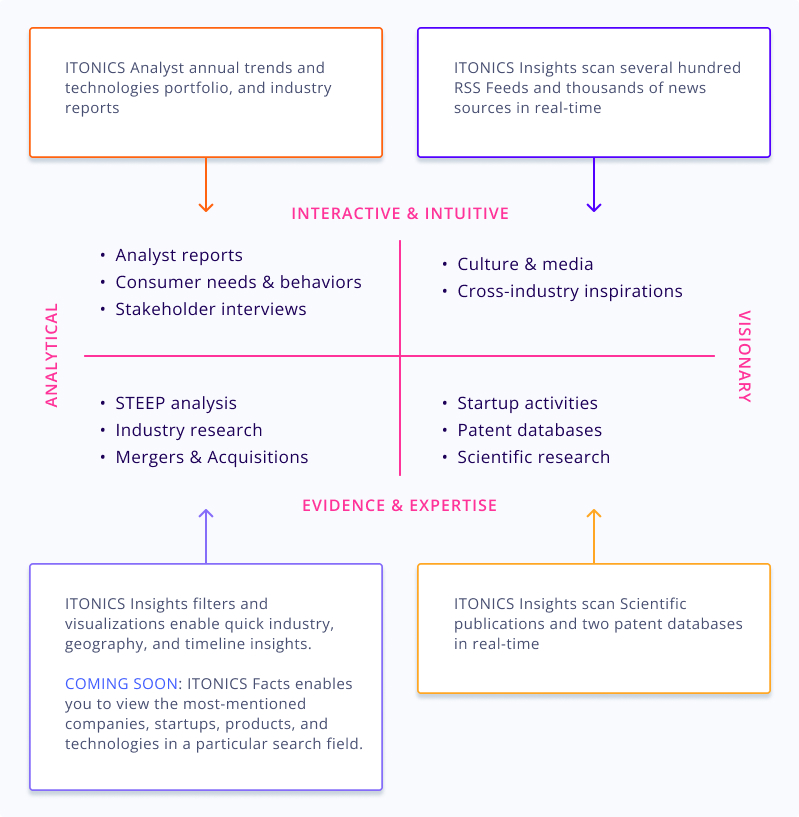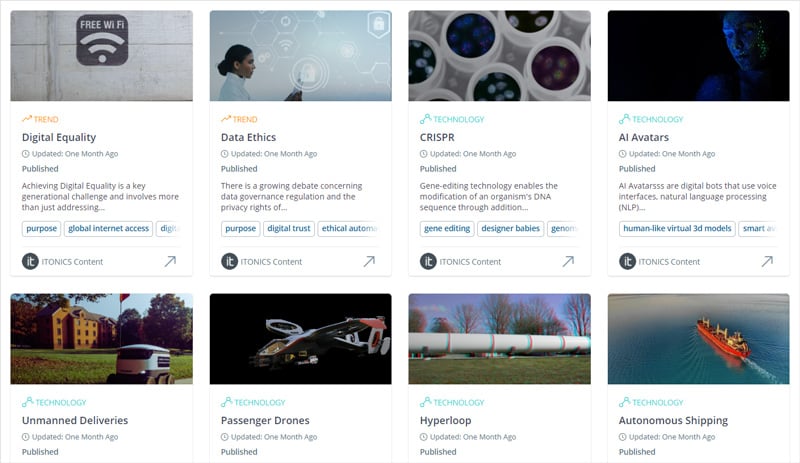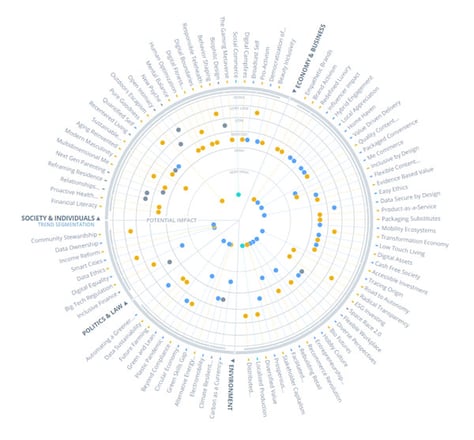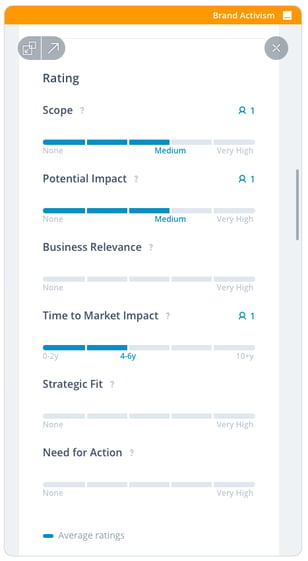End2End Innovation Management begins by asking the fundamental question, "Where to Play?". Answering this question relies on several congruent activities and internal capabilities that primarily fall within the discipline of strategic foresight. Organizations equipped with strong foresight capabilities can align their strategy with future scenarios and build resilience in an increasingly uncertain and competitive landscape.
What is environmental scanning, and why is it important?
Environmental scanning is the capability to scan the (business) environment comprehensively and continuously.
Essential in strategic foresight is an organization’s capacity to scan its business environment. Environmental scanning helps make sense of the various factors that have relevance and impact in this environment. It focuses on activities that enable the identification of new opportunities for growth, possible threats for mitigation, informing strategic priorities, and shaping future goals.
The practice of environmental scanning has been around for as long as people have tried to preempt threats and capitalize on opportunities. However, the systematic collection and interpretation of relevant data for strategic planning—environmental scanning as we know it today—was popularized by futurists in the mid to late twentieth century.
Sometimes referred to as Futures Scanning Systems, Early Warning Systems, Future Intelligence Systems, and Horizon Scanning, environmental scanning methods can differ but share an exploratory process, a future-oriented lens, and the output of actionable intelligence.
The business environment comprises internal and external drivers of change, including capabilities, trends, disruptive and emerging technologies, startups, competitors, markets, business models, risks, regulations, and customer needs.
Common innovation terminology that environmental scanning practitioners will encounter includes:
|
Term |
Definition |
| Scouting |
Scouting is the process of collecting pertinent data that contextualizes change and leads to uncovering weak signals. |
| Weak signal | A weak signal represents the first sign of discontinuity or change. Weak signals are only indicators of change and will have to be qualified and evaluated during the environmental scanning processes. |
| Trend | As an expression of new consumer attitudes, expectations, or behaviors, trends present consumer and market shifts that drive new change. Trends are an indication of market PULL; guiding innovators in knowing what consumers need, desire, and occasionally demand. |
| Emerging Technology | Emerging Technologies represent a market PUSH; driven by R&D and innovation, these are the tools capable of meeting—and sometimes creating—new needs, desires, and demands. |
| Inspiration | An inspiration is evidence of how organizations or individuals are responding to a trend or emerging technology in the real world. Inspirations serve as springboards for ideation, helping innovators look beyond their category, connect information in new ways, and nurture fresh thinking. |
| STEEP | STEEP—social, technological, economic, environmental, and political—is a framework for segmenting the environment across dimensions to facilitate scanning and analysis. It indicates where an observed change is occurring. |
The ultimate goal in environmental scanning is to find the substantial starting points that will ignite new thinking, catalyze action, and engage customers.
The fundamentals of environmental scanning
Getting started with environmental scanning requires a clear structure for managing the flow of information. Foresight managers must first understand their organization’s current environmental scanning techniques and define the key objectives. This will help establish the scope of environmental scanning activities and search fields. Primary activities include trend and emerging technology scouting, competitor watch, and startup and partner scouting.
The information and insights collected during these activities are only as good as the sources from which they are derived. A rigorous methodology should balance tangible scientific, technological, and social data insights while also recognizing the significance of the intangible, value-driven changes in society.
Valuable sources of data and information can be found across four quadrants—from analytic to visionary and from interactive & intuitive to evidence & expertise.

A common challenge organizations face in environmental scanning is mitigating the “noise” to find and act on relevant information and impact. Internal, collaborative evaluation of trends, technologies, and other drivers of change can serve as a means of discerning relevance and help teams understand what these elements might mean for their business. Based on the unique industry- and company-specific criteria, the internal evaluation also helps empower teams with the consensus needed to ensure strategic alignment, strengthen buy-in, and act decisively.
Defining the team and responsibilities upfront ensures that the right competencies and areas of expertise are leveraged. An environmental scanning team consists of the following roles:
- Scout: actively searches for and tracks relevant signals
- Analyst: monitors the evolution of signals to trends, technologies, and other drivers of change, and eventually to opportunities
- Expert: evaluates the drivers of change according to defined criteria
- Foresight Manager: establishes the process and is responsible for the outcomes

Teams can streamline their environmental scanning capabilities through centralization and automation:
- Firstly, having a central platform to collect information can reveal connections between related drivers of change and allow for sharing information between team members and business units. A single point of truth helps to create a shared understanding, fosters discussions about the importance of factors, and facilitates internal evaluation.
- Secondly, integrating a tool that can automate the scanning process can provide teams with a comprehensive birds-eye view of potential opportunity spaces.
4 steps to enhance your environmental scanning process
1. Reinforce your scouting and scanning
Innovation team capabilities need to be clearly understood so that gaps and opportunities for increased output can be augmented with digital tools, machine learning, and AI. The sheer volume of raw data that needs to be collected can easily become problematic. Subsequently, filtering information to display what is most relevant and important is another crucial step. A common assumption would be that these steps become easier when innovation teams grow; however, more team members do not necessarily mean that the scouting and scanning capabilities are enhanced.
Identifying a wide variety of sources from where scouting and scanning information can be garnered is essential for ensuring a complete view. This ‘total’ view often uses the STEEP, or PESTEL (also known as STEP, PESTLE, or PEST) analysis methodologies to encourage ‘total’ environmental scanning. Scouting and scanning processes should enable both a birds’ eye and fish-eye view of the environment. This requires the environmental scanning process to take an overall approach first, and then through structured steps, views become more partial as connections start to become evident. Connections and relations between weak signals guide the sense-making process, and systems and tools need to be positioned to support this process.
2. Consider internal and external factors during the sense-making phase
Thorough and structured scouting and scanning become useful through the sense-making processes. During this phase, teams need to be able to identify patterns from the vast amounts of data, and through connecting data, important patterns appear from which teams will commence their sense-making phases.
Teams need to inquire which factors, directly and indirectly, impact the organization, and internal and external factors should be taken into account. Degrees of impact is crucial to map out as internal factors will determine capacity and strategic planning, and external factors of influence use trend and technology insights that indicate opportunity spaces.
The sense-making process requires digital and physical interlinkages, as well as scientific and intuitive activities. Having the ability to quickly view the numbers of data points, relations, and current impact is imperative for quick responses. However, leveraging human capital will help ensure a deeper understanding of opportunities and threats.
The future is, in a profound sense, unknowable. But not everything is uncertain; some things are relatively predictable. We can do a respectable job of "sensing" the basic dynamics of the future and the alternative courses they might take.
James L. Morrison and Ian Wilson
3. Leverage internal and external expertise to support decision-making
Asking questions around what changing environments, behaviors, expectations, and mindsets are and how they will influence the future helps us identify opportunity spaces and threats. Organizations want to leverage opportunities and turn threats into opportunities to gain a competitive advantage. Opportunity spaces may illuminate new markets, R&D of new or complementary products or services, integrate technologies, optimize processes, realign purpose, or change interactions with people.
To enable, firstly, the identification of opportunity spaces and secondly, shape strategic response needs to involve cross-organizational input. In addition, robust insights from the sense-making process may require input and collaboration from experts outside the organization. Involving the right people at the right moments along this part of the innovation journey can significantly expedite and organize efforts—systems, and tools that enable systematic collaboration resulting in more efficient and ultimately successful innovations.
4. Continuously engage in environmental scanning
To respond to rapid changes, organizations must integrate continuous environmental scanning processes into strategic mapping. Environmental scanning is an early warning system that helps organizations adapt quickly and effectively. Unlike project-based scanning, continuous scanning can only be sustainably implemented when efficient systems and tools can optimize the processes.
How ITONICS enhances your environmental scanning
The ITONICS Innovation OS helps innovation architects discover, collect and evaluate emerging trends and technologies in one central location.
The automatic discovery of weak signals from a wide variety of sources globally with ITONICS Insights speeds up the scanning and scouting processes significantly and assists teams in the systematic organization and evaluation of elements during the sense-making process. The ITONICS rate and review functionalities provide easy ways to garner collaborative input and visualize the input in ways to identify relevant trends and technologies for your organization easily.
Now, take the first step to kickstart your innovation journey: Learn more about how to harness machine intelligence to translate data into insights with ITONICS in our How-To Guide. The guide also includes best practices on how other industry leaders scan and scout to identify new opportunities.
→ How-To Guide: Environmental Scanning with ITONICS Insights

 |
 |
Enabling sustainable and uncomplicated ways for employees to capture what they deem relevant for organizational innovation can provide a wider scouting and scanning lens and encourage awareness to participate in the innovation journey actively.



/Assets%20and%20Heros/nav-thumbnail-Gartner.webp?width=150&name=nav-thumbnail-Gartner.webp)






/How-to-Use-Environmental-Scanning-in-Your-Innovation-Journey-fullwidth.webp??&width=900&height=450&name=How-to-Use-Environmental-Scanning-in-Your-Innovation-Journey-fullwidth.webp)

